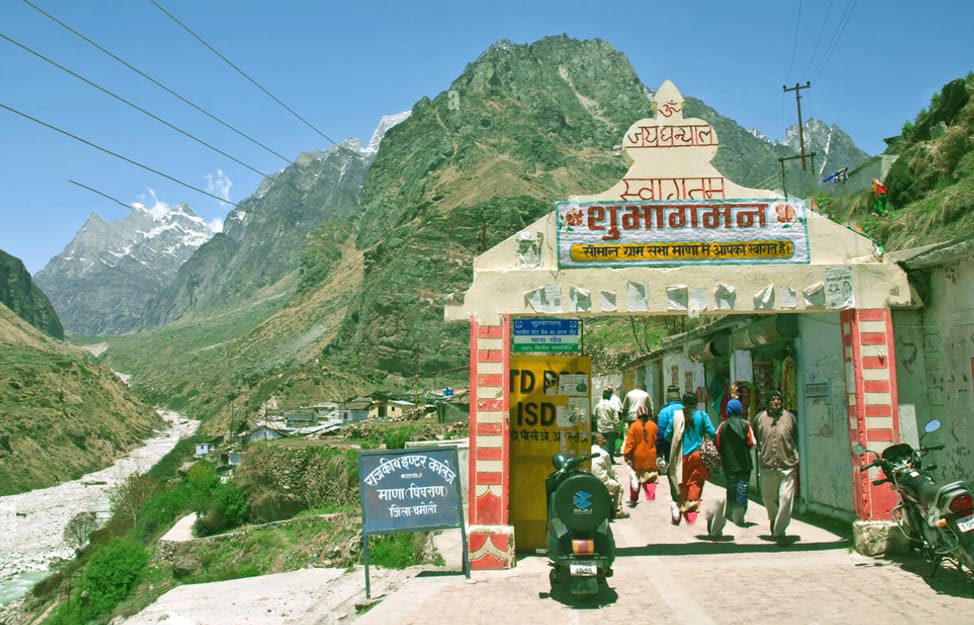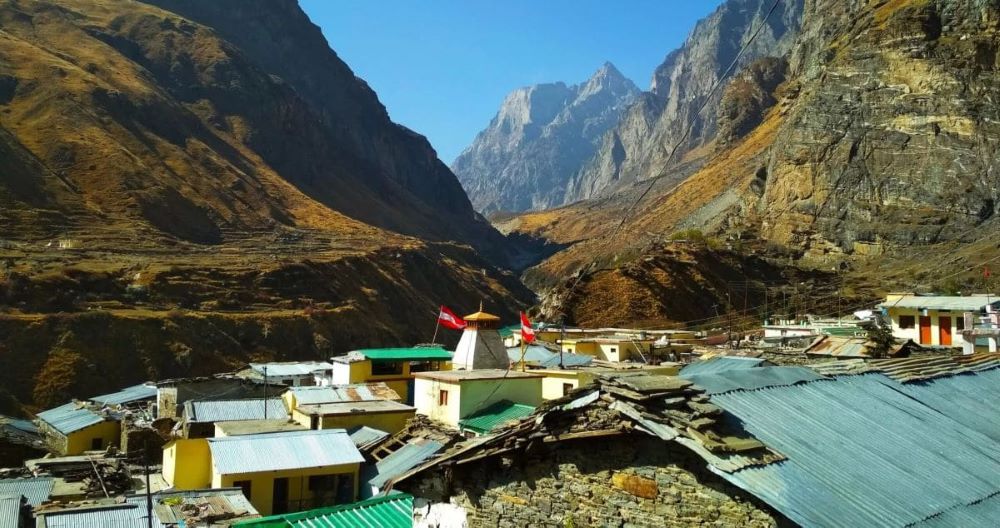
Badrinath Tourism: Best Places, Things to Do and Stay
Explore the spiritual haven of Badrinath tourism. Discover sacred temples, breathtaking Himalayan views, and cultural richness in this revered pilgrimage destination.
In This Badrinath Tourism Article:
Nestled amidst the majestic peaks of the Himalayas, Badrinath stands as one of the holiest and most revered pilgrimage destinations in India. Situated in the Chamoli district of Uttarakhand, this sacred town holds immense religious significance for Hindus and attracts millions of devotees from around the world. Let’s delve into the enchanting world of Badrinath tourism and discover what makes it a spiritual haven:
At the heart of Badrinath lies the iconic Badrinath Temple, dedicated to Lord Vishnu. According to Hindu mythology, Badrinath is one of the Char Dham pilgrimage sites, and a visit to this sacred temple is believed to cleanse the soul of sins and bestow divine blessings upon devotees.
Embarking on a pilgrimage to Badrinath is a transformative journey for many. Pilgrims undertake arduous treks, and long journeys, and endure harsh weather conditions to pay homage to Lord Vishnu at the revered Badrinath Temple. The spiritual aura of the temple and the surrounding Himalayan landscape create an atmosphere of divine grace and serenity.
Badrinath is blessed with breathtaking natural beauty, with snow-capped peaks, verdant valleys, and glistening rivers adorning its landscape. The town serves as a gateway to several scenic spots such as Mana Village, Vasudhara Falls, and the Neelkanth Peak, offering visitors a chance to immerse themselves in the serene ambience of the Himalayas.
The Best Time to Visit Badrinath
Badrinath is not just a pilgrimage site but a spiritual sanctuary that beckons devotees and travellers from around the world. While the town holds its allure throughout the year, choosing the best time to visit Badrinath can enhance your experience and ensure a memorable journey amidst the majestic mountains. Here’s a guide to help you plan your divine sojourn to Badrinath:

Summer Season
(May to June)
The summer months from May to June mark the peak tourist season in Badrinath. During this time, the weather is pleasant, with daytime temperatures ranging from 10°C to 25°C, making it ideal for sightseeing and outdoor activities. The Badrinath Temple opens its doors to devotees, and the town comes alive with religious fervor and cultural festivities. It’s the perfect time to embark on a spiritual pilgrimage and witness the vibrant atmosphere of Badrinath.

Monsoon Season
(July to September)
The monsoon season in Badrinath, from July to September, brings with it heavy rainfall and the risk of landslides and roadblocks. While the lush greenery and rejuvenated landscapes add to the scenic beauty of the region, the unpredictable weather can disrupt travel plans and pilgrimage activities. It’s advisable to exercise caution and stay updated on weather forecasts if you plan to visit Badrinath during the monsoon season.

Autumn Season
(October to November)
Autumn is considered one of the best times to visit Badrinath, as the weather remains pleasant and the skies clear up after the monsoon season. From October to November, the town experiences mild temperatures and crisp, clear days, with the bonus of stunning views of the surrounding Himalayan peaks adorned with autumnal hues. The post-monsoon period also sees fewer crowds, allowing for a more peaceful and serene pilgrimage experience.
Things to Do in Badrinath

Badrinath, nestled amidst the picturesque Himalayas in Uttarakhand, is not just a pilgrimage destination but also a haven for nature lovers and adventure enthusiasts. Here are some must Things to do in Badrinath tourism:
Visit the Badrinath Temple:
No trip to Badrinath is complete without a visit to its namesake temple, dedicated to Lord Vishnu. Marvel at the intricate architecture, offer prayers and soak in the spiritual ambience of this ancient shrine.
Take a Holy Dip in the Tapt Kund:
Located near the Badrinath Temple, the Tapt Kund is a natural hot spring known for its therapeutic properties. Take a dip in its sacred waters to cleanse your soul and rejuvenate your body.
Explore Mana Village:
Pay a visit to Mana Village, the last inhabited village before the Indo-Tibetan border. Explore its quaint lanes, interact with the friendly locals, and marvel at the stunning vistas of the surrounding Himalayan landscape.
Trek to Vasudhara Falls:
Embark on a scenic trek from Mana Village to Vasudhara Falls, a mesmerizing cascade nestled amidst lush greenery. The trek offers breathtaking views of the Himalayas and culminates in the awe-inspiring sight of the waterfall.
Witness the Neelkanth Peak:
Gaze in awe at the majestic Neelkanth Peak, which towers over Badrinath with its snow-capped summit. Capture stunning photographs of this iconic Himalayan peak and immerse yourself in the tranquillity of the surroundings.
Visit the Charan Paduka:
Make a pilgrimage to the Charan Paduka, a sacred rock bearing the footprints of Lord Vishnu. Located near Badrinath, this revered site offers panoramic views of the town and the surrounding mountains.
Experience Aarti at Badrinath Temple:
Witness the mesmerizing evening Aarti ceremony at the Badrinath Temple, where priests offer prayers to the deity accompanied by chanting and devotional music. Experience the divine atmosphere and immerse yourself in spiritual fervour.
Indulge in Local Cuisine:
Savour the authentic flavours of Garhwali cuisine at the local eateries in Badrinath. Don’t miss out on delicacies like Aloo ke Gutke, Mandua ki Roti, and Bal Mithai, which are sure to tantalize your taste buds.
Seek Blessings at Brahma Kapal:
Pay homage to your ancestors and seek blessings at Brahma Kapal, a sacred site on the banks of the Alaknanda River. Perform ancestral rites and rituals to honour your loved ones and seek spiritual solace.
Exploring Places to Visit in Badrinath Tourism

Badrinath, nestled amidst the majestic Himalayas in Uttarakhand, is not only a revered pilgrimage destination but also a haven for nature lovers and adventure enthusiasts. Here are some places to visit in Badrinath tourism:
Badrinath Temple:
The iconic Badrinath Temple, dedicated to Lord Vishnu, is the most prominent attraction in Badrinath. Dating back to ancient times, this temple is renowned for its intricate architecture, vibrant paintings, and spiritual significance. Pilgrims from all over the world flock to seek blessings and spiritual solace at this sacred shrine.
Tapt Kund:
Tapt Kund is a natural hot spring located near the Badrinath Temple. Believed to have medicinal properties, the hot springs are frequented by pilgrims who take a dip in the sacred waters before entering the temple. The soothing waters provide relief from fatigue and rejuvenate the body and mind.
Charan Paduka:
Located at a short distance from Badrinath, Charan Paduka is a sacred rock bearing the footprints of Lord Vishnu. Pilgrims believe that these footprints belong to Lord Vishnu when he descended from Vaikuntha to bless the earth. The site offers panoramic views of the surrounding mountains and valleys.
Narad Kund:
Narad Kund is a sacred water body located near the Badrinath Temple, believed to be the abode of the sage Narada. Pilgrims take a dip in the pristine waters of Narad Kund before visiting the temple, as it is considered auspicious and purifying.
Brahma Kapal:
Brahma Kapal is a revered site on the banks of the Alaknanda River, where devotees perform ancestral rites and offer prayers for the salvation of their departed ancestors. The site holds immense religious significance and is visited by pilgrims seeking spiritual solace.
Mana Village:
Located just a few kilometres from Badrinath, Mana Village is the last inhabited village before the Indo-Tibetan border. Surrounded by stunning vistas of the Himalayas, this quaint village offers a glimpse into traditional Himalayan culture and lifestyle. Visitors can explore the picturesque surroundings and interact with the friendly locals.
- Saraswati River: The mythical Saraswati River originates near Mana Village and adds to the mystical charm of Badrinath. Visitors can take a leisurely stroll along the banks of the river, soaking in the serene ambience and pristine beauty of the surroundings.
- Bheem Pul: Legend has it that the mighty Pandava prince Bhima constructed a natural bridge, known as Bheem Pul, across the Saraswati River. This marvel of nature is located near Badrinath and is a popular spot for tourists to marvel at the architectural prowess of ancient times.
- Ganesh Gufa: Ganesh Gufa, also known as Ganesh Cave, is a natural cave located near Mana Village. It is believed to be the place where the sage Vyasa narrated the Mahabharata to Lord Ganesha. The cave offers a serene atmosphere for meditation and introspection.
Vasudhara Falls:
Embark on a scenic trek from Mana Village to Vasudhara Falls, a mesmerizing cascade nestled amidst lush greenery and towering cliffs. The trek offers breathtaking views of the Himalayan peaks and culminates in the sight of the waterfall plunging from a height of over 400 feet.
Neelkanth Peak:
Admire the majestic Neelkanth Peak, which towers over Badrinath, with its snow-capped summit piercing the azure sky. The peak is a popular trekking destination and offers panoramic views of the surrounding valleys and peaks.
Mata Murti Temple:
Dedicated to Mata Murti, the mother of Lord Narayana (Vishnu), this ancient temple is located on the banks of the Alaknanda River, about 3 kilometres from Badrinath. The temple is visited by devotees seeking blessings for the well-being of their families.
How to reach Badrinath?
Visiting this revered pilgrimage destination requires careful planning and consideration of various transportation options. Here’s a detailed guide on how to reach Badrinath:
By Road:
- The most common way to reach Badrinath is by road. The town is well-connected to major cities and towns in Uttarakhand and neighbouring states by a network of roads.
- National Highway 7, also known as the Badrinath Highway, provides access to Badrinath from cities like Haridwar, Rishikesh, Dehradun, and Delhi.
- Travellers can hire taxis, buses, or shared jeeps from these cities to reach Badrinath. The journey by road offers breathtaking views of the Himalayan landscape and takes approximately 10-12 hours from Haridwar and Rishikesh, and around 16-18 hours from Delhi.
By Air:
- The nearest airport to Badrinath is the Jolly Grant Airport in Dehradun, situated approximately 310 kilometres away.
- From the airport, travellers can hire taxis or take a bus to reach Badrinath via Rishikesh and Joshimath. The journey by air and road takes approximately 12-14 hours, depending on the traffic and road conditions.
By Train:
- The nearest railway station to Badrinath is the Rishikesh Railway Station, located approximately 295 kilometres away.
- From Rishikesh, travellers can hire taxis or take a bus to reach Badrinath via Joshimath. The journey by train and road takes approximately 10-12 hours, offering scenic views of the Himalayan foothills and river valleys along the way.
Important Tips:
- Check the weather conditions and road status before embarking on your journey to Badrinath, especially during the monsoon and winter when certain routes may be affected by landslides or snowfall.
- Carry sufficient water, snacks, and necessary medications, especially if you’re travelling by road or trekking to Badrinath, as facilities may be limited in remote areas.
- Plan your accommodation in advance, as options may be limited in Badrinath due to its remote location and limited infrastructure.
Distance Chart From Badrinath
| City or Destinations | Distances |
|---|---|
| Mana Village | 3 km |
| Joshimath | 41 km |
| Govind Ghat | 25 km |
| Chamoli | 103 km |
| Rudraprayag | 154 km |
| Rishikesh | 291 km |
| Haridwar | 311 km |
| Dehradun | 327 km |
| Delhi | 552 km |
| Kedarnath | 224 km |
| Uttarkashi | 326 km |
Frequently Asked Questions on Badrinath Tourism
What is the significance of Badrinath tourism?
Badrinath is a sacred town in Uttarakhand, revered as one of the Char Dham pilgrimage sites in Hinduism. It is believed to be the abode of Lord Vishnu and holds immense religious significance for devotees.
When is the best time to visit Badrinath?
The best time to visit Badrinath is during the summer months from May to June and the autumn months from September to October. The weather is pleasant during these months, making it ideal for pilgrimage and tourism.
What are the accommodation options available in Badrinath?
Badrinath Tourism offers a range of accommodation options, including hotels, guesthouses, Dharamshala, ashrams, camping sites, and homestays. Travelers can choose accommodation based on their preferences and budget.
Are there any trekking routes near Badrinath?
Yes, there are several trekking routes near Badrinath, including the trek to Vasudhara Falls, Satopanth Lake, Valley of Flowers, and Hemkund Sahib. These treks offer stunning views of the Himalayas and opportunities for adventure.
Are there any trekking routes near Badrinath?
Yes, there are several trekking routes near Badrinath, including the trek to Vasudhara Falls, Satopanth Lake, Valley of Flowers, and Hemkund Sahib. These treks offer stunning views of the Himalayas and opportunities for adventure.
Is it safe to travel to Badrinath?
Yes, Badrinath tourism is considered a safe destination for travellers. However, it’s essential to take necessary precautions, such as checking weather conditions, carrying adequate supplies, and following local regulations during your visit.
Are there any festivals celebrated in Badrinath?
Yes, several festivals are celebrated in Badrinath throughout the year, including the Badri-Kedar Festival, Maha Shivaratri, and Hemkund Sahib Yatra. These festivals attract pilgrims and tourists from far and wide to participate in religious rituals and cultural events.

